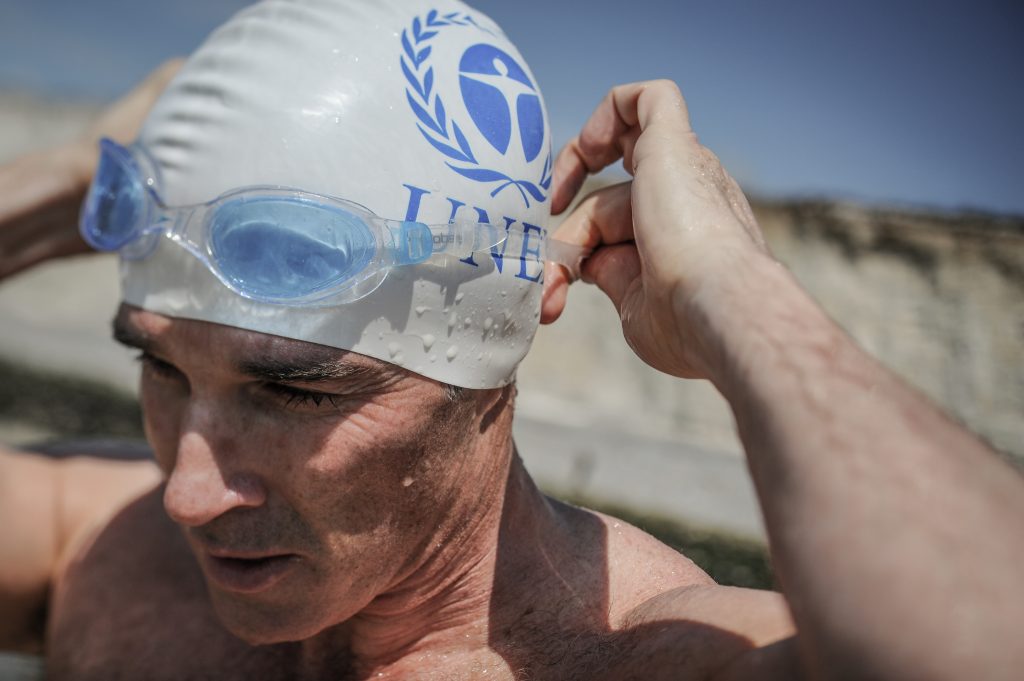
Legendary endurance swimmer and UN Patron of the Oceans, Lewis Pugh, will take on the toughest swim of his career later this month, when he attempts to swim across the mouth of the Ilulissat Icefjord in Greenland. The Arctic swim will highlight the impact of climate change in the region.
The ground-breaking swim spans a distance of 10km. However, Pugh anticipates the swim may be longer and could take up to two weeks to complete, due to the presence of icebergs and brash ice that he will have to navigate. He intends to swim one kilometre per day in the freezing Arctic waters, before heating back-up and repeating again the next day. This will be the first 10+ day swim attempted in the Arctic.
Pugh is no stranger to cold water swims having swum in the Arctic and Antarctica to highlight the impact of the climate crisis. However, Pugh believes this swim will test him like no other, writing that, “This will be the longest, coldest swim of my life.” He goes on to say that, “No one has tested the cumulative effects of swimming, day after day, in water that can drop to minus 1.7°C – and that’s before you take the wind chill factor into account.”
Thirteen years ago, Pugh completed a kilometre swim across the North Pole which took him 20 minutes. In waters this cold, he says, “Each minute felt like a lifetime.” Now he will have to swim a kilometre each day in the same temperatures and repeat the process until he’s made the ten kilometre crossing.
According to Pugh, the Ilulissat Icefjord is home to the fastest moving glacier in the world. In his blog, he writers that, “The Ilulissat Glacier, on the west coast of Greenland, drains around 30 cubic kilometres of ice per year into the sea. Some of the icebergs that break from the glacier are over one kilometre tall.” Located 250km north of the Arctic Circle, it produces an estimated 10% of icebergs stemming from Greenland.
The glacier is a UNESCO World Heritage Site and melts at an increasing rate because of rising temperatures. It averages a melt rate of 30m per day. For this reason, Pugh believes there is no better place to highlight the climate crisis.
There is a clear purpose for Pugh’s swim. In November, world leaders will gather for the pivotal COP26 climate summit in Glasgow. Pugh intends to send them an unambiguous message about the state of our climate: we’re running out of time to decisively act to prevent a plethora of destructive and worsening climate impacts, including sea level rise from melting ice sheets. “I will remind them,” says Pugh, “that we rely on ice for our survival. It keeps our planet’s temperature in a range within which we can live. No ice, no life.”
The cold water swims have a massive impact on the body, and Pugh has nearly lost his life doing them. “I’ve swum until I couldn’t feel my fingers and feet,” writes Pugh, “I’ve swum until my tongue froze inside my mouth. I’ve swum until I could feel my body shutting down. I don’t know how much longer I will be able to do this. This swim has to be my last stand. The stakes have never been higher.”
Pugh’s intends to complete the Ilulissat Icefjord swim from the 25th August to the 5th September. He will also attend the COP26 climate conference in November.
On Monday 9th August, the Intergovernmental Panel on Climate Change (IPCC) released a damning report on our collective failure towards addressing the climate crisis over the past 33 years. We’ve warmed the planet at an “unprecedented” rate compared to anything seen over thousands of tens of thousands of years. That human activities are responsible for the temperature rise is “unequivocal”.
By undertaking this swim, Pugh hopes to break politicians out of their reverie and to rapidly reduce emissions and better protect our oceans and environment. Our collective future depends on it. We therefore have to be grateful for the lengths that people like Lewis Pugh go to, in order to protect our living world.